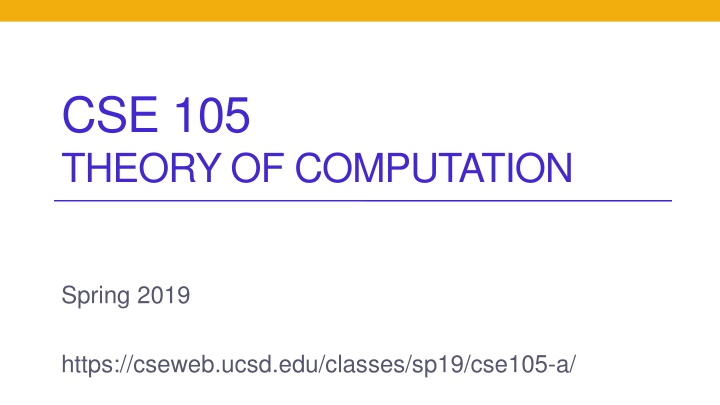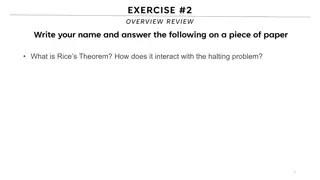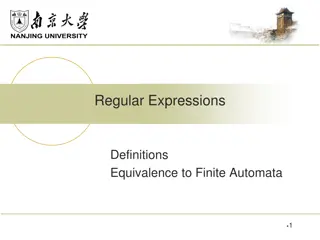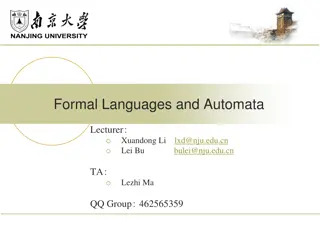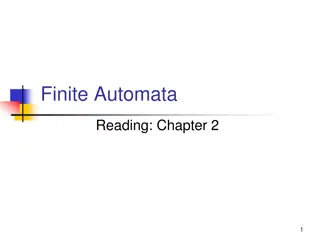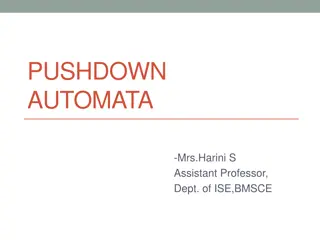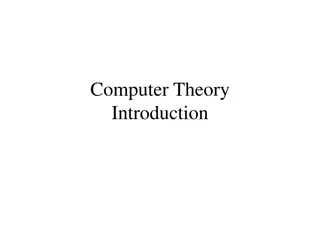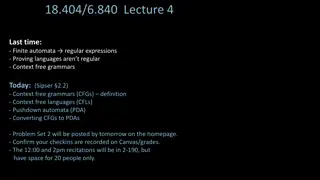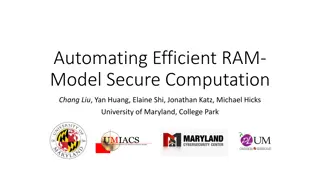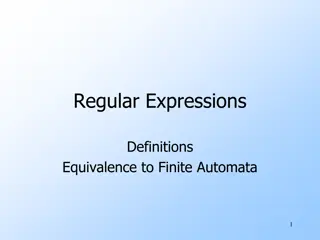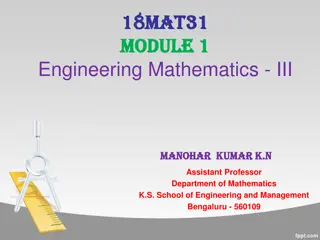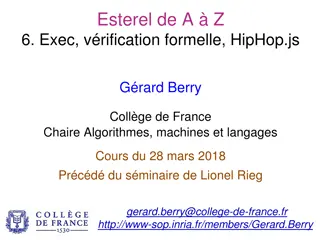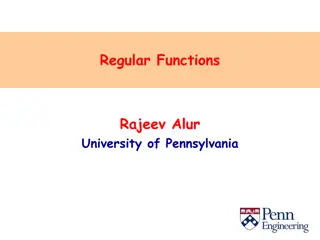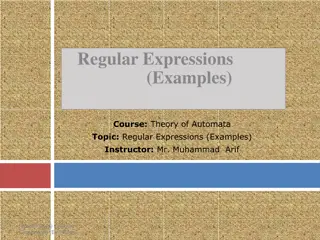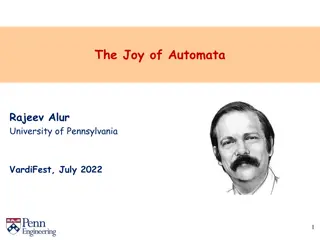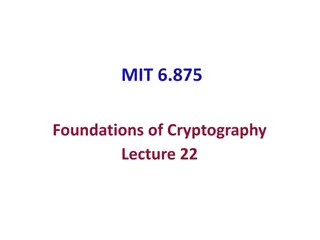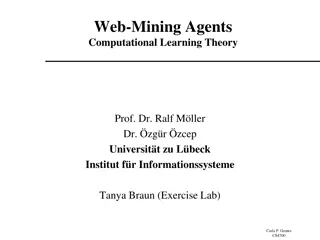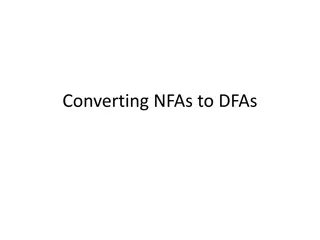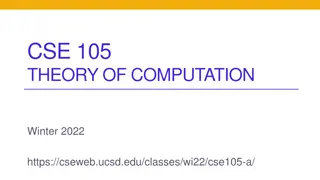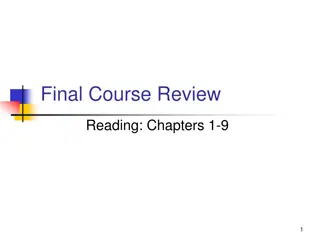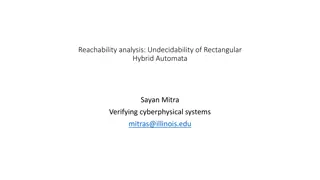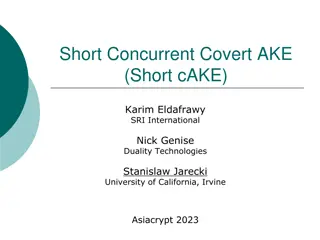Theory of Computation: CFG, CFLs, and Pushdown Automata
Dive into the world of Context-Free Grammars (CFGs), Context-Free Languages (CFLs), and Pushdown Automata in the realm of theoretical computer science. Explore ambiguity in grammars, learn how to define pushdown automata, compare regular languages with CFLs, and understand the intricacies of language generation.
Uploaded on Feb 20, 2025 | 0 Views
Download Presentation

Please find below an Image/Link to download the presentation.
The content on the website is provided AS IS for your information and personal use only. It may not be sold, licensed, or shared on other websites without obtaining consent from the author.If you encounter any issues during the download, it is possible that the publisher has removed the file from their server.
You are allowed to download the files provided on this website for personal or commercial use, subject to the condition that they are used lawfully. All files are the property of their respective owners.
The content on the website is provided AS IS for your information and personal use only. It may not be sold, licensed, or shared on other websites without obtaining consent from the author.
E N D
Presentation Transcript
CSE 105 THEORY OF COMPUTATION Spring 2019 https://cseweb.ucsd.edu/classes/sp19/cse105-a/
Review of CFG, CFL, ambiguity What is the language generated by the CFG below: G1= ({S,T1,T2}, {0,1,2}, { S T1| T2, T1 0T11 | , T2 0T22 | }, S) In the grammar G2= ({S}, {0,1}, { S SS | 0 } , S) S SS 0S 00 S SS S0 00 are both derivations of the string 00. Does this mean that G2is ambiguous?
Today's learning goals Sipser Ch 1.4, 2.1 Define push down automata Trace the computation of a push down automaton Design a push down automaton recognizing a given language Compare class of regular languages and class of CFLs
Birds' eye view All languages over Context-free languages over Regular languages over Finite languages over
Recap: Context-free languages Context-free grammar One-step derivation Derivation Language generated by grammar
An alternative Sipser p. 109 NFA + stack
Pushdown automata Sipser p. 109 NFA + stack At each step 1. Transition to new state based on current state, letter read, and top letter of stack. 2. (Possibly) push or pop a letter to (or from) top of stack
Pushdown automata Sipser p. 109 NFA + stack Accept a string if there is some sequence of states and some sequence of stack contents which processes the entire input string and ends in an accepting state.
State diagram for PDA Sipser p. 109 If hand-drawn or in Sipser State transition labelled a, b c means "when machine reads an a from the input and the top symbol of the stack is a b, it may replace the b with a c."
State diagram for PDA Sipser p. 109 If hand-drawn or in Sipser State transition labelled a, b c means "when machine reads an a from the input and the top symbol of the stack is a b, it may replace the b with a c." What edge label would indicate "Read a 0, don't pop anything from stack, don t push anything to the stack"? A. 0, B. , 0 C. , 0 D. , 0 E. I don't know.
Designing a PDA L = { 0i1i+1| i 0 } Which of these CFGs generate L? Assume V = set of variables mentioned in rules; ={0,1}, S start A. S | 0S1 B. S | 0S11 C. S T1 | 0S1, T D. S | 0T1, T | 0T1 E. I don't know.
Designing a PDA L = { 0i1i+1| i 0 } Informal description of PDA: Read symbols from the input. As each 0 is read, push it onto the stack. As soon as 1s are seen, pop a 0 off the stack for each 1 read. If the stack becomes empty and there is exactly one 1 left to read, read that 1 and accept the input. If the stack becomes empty and there are either zero or more than one 1s left to read, or if the 1s are finished while the stack still contains 0s, or if any 0s appear in the input following 1s, reject the input.
Useful trick What would , A. Without reading any input or popping any symbol from stack, push $ B. If the input string and stack are both empty strings, push $ C. At the end of reading the input string, push $ to top of stack D. I don't know. $ mean?
Useful trick What would , A. Without reading any input or popping any symbol from stack, push $ B. If the input string and stack are both empty strings, push $ C. At the end of reading the input string, push $ to top of stack D. I don't know. $ mean? Why is this useful? Commonly used from initial state (at start of computation) to record top of stack with a special symbol) "If the stack becomes empty and "
Designing/Tracing a PDA L = { 0i1i+1| i 0 } Sample computations? - nondeterminism - stack contents
PDAs and CFGs are equivalently expressive Theorem 2.20: A language is context-free if and only some nondeterministicPDA recognizes it. Consequences - Quick proof that every regular language is context free - To prove closure of class of CFLs under a given operation, can choose two modes of proof (via CFGs or PDAs) depending on which is easier
Example L = { aibjck| i=j or i=k, with i,j,k 0 } Which of the following strings are not in L? A. b B. abc C. abbcc D. aabcc E. I don't know.
Example L = { aibjck| i=j or i=k, with i,j,k 0 } To design a CFG that generates L L = { aibjck| i=j, with i,j,k 0 } U { aibjck| i=k, with i,j,k 0 }
Example L = { aibjck| i=j or i=k, with i,j,k 0 } To design a CFG that generates L L = { aibjck| i=j, with i,j,k 0 } U { aibjck| i=k, with i,j,k 0 } S Sc | T T aTb |
Example L = { aibjck| i=j or i=k, with i,j,k 0 } To design a CFG that generates L L = { aibjck| i=j, with i,j,k 0 } U { aibjck| i=k, with i,j,k 0 } S T | aSc T Tb |
Designing a PDA L = { aibjck| i=j or i=k, with i,j,k 0 } Informal description of PDA: How would you design an algorithm that, given a string, decides if it is in this set? - What information do you need to track? - How much memory do you need? - Are you using non-determinism?
Designing a PDA L = { aibjck| i=j or i=k, with i,j,k 0 } Informal description of PDA: The PDA pushes a $ to indicate the top of the stack, then starts reading a's, pushing each one on to the stack. The PDA guesses when it's reached the end of the a's and whether to match the number of a's to the number of b's or the number of c's. If trying to match number of b's with number of a's: PDA pops off a's for each b read. If there are more a's on the stack but no more b's being read, reject. When the end of the stack ($) is reached, the number of a's matches the number of b's. If this is the end of the input or if any number of c's is read at this point, accept; otherwise, reject. If trying to match the number of c's with number of a's: first read any number of b's without changing stack contents and then nondeterministically guess when to start reading c's. For each c read, pop one a off the stack. When the end of the stack ($) is reached the number of a's and c's so far match.
Designing a PDA L = { aibjck| i=j or i=k, with i,j,k 0 } Formal definition of PDA:
Conventions for PDAs Can "test for end of stack" without providing details We can always push the end-of-stack symbol, $, at the start. Can "test for end of input" without providing details Can transform PDA to one where accepting states are only those reachable when there are no more input symbols. Don't always need to provide a state transition diagram!
